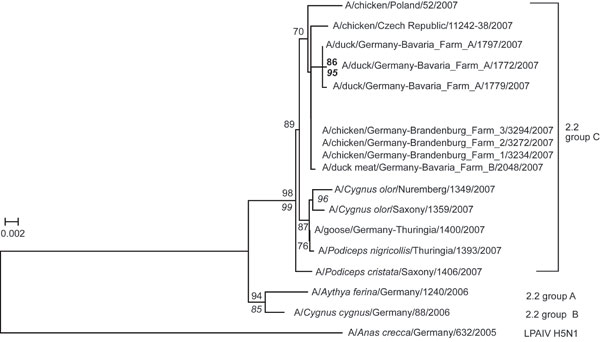Highly Pathogenic Avian Influenza Virus (H5N1) in Frozen Duck Carcasses, Germany, 2007
Timm C. Harder, Jürgen Teuffert, Elke Starick, Jörn Gethmann, Christian Grund, Sasan Fereidouni, Markus Durban, Karl-Heinz Bogner, Antonie Neubauer-Juric, Reinhard Repper, Andreas Hlinak, Andreas Engelhardt, Axel Nöckler, Krzysztof Smietanka, Zenon Minta, Matthias Kramer, Anja Globig, Thomas C. Mettenleiter, Franz J. Conraths, and Martin Beer

Author affiliations: Friedrich-Loeffler-Institut, Isle of Riems, Germany (T.C. Harder, E. Starick, C. Grund, S. Fereidouni, M. Durban, A. Globig, T.C. Mettenleiter, M. Beer); Friedrich-Loeffler-Institut, Wusterhausen, Germany (J. Teuffert, J. Gethmann, M. Kramer, F.J. Conraths); Bavarian Agency for Health and Food Safety, Erlangen, Germany (K.H. Bogner; R. Repper); Bavarian Agency for Health and Food Safety, Oberschleissheim, Germany (A. Neubauer-Juric); Brandenburg State Central Laboratory, Frankfurt/Oder, Germany (A. Hlinak, A. Engelhardt); Agency for Consumer Protection and Food Safety of Lower Saxony, Oldenburg, Germany (A. Nöckler); National Veterinary Research Institute, Pulawy, Poland (K. Smietanka, Z. Minta)
Main Article
Figure 2

Figure 2. Phylogetic tree of the hemagglutinin (HA) gene (full-length sequence) of highly pathogenic avian influenza virus (HPAIV) (H5N1) detected in poultry from Brandenburg and Bavaria, Germany, in 2007, including sequences of wild birds and poultry from neighboring countries. Sequence of the Czech poultry isolate is supported by GenBank. The tree was constructed by using a minimal-evolution algorithm; numbers represent bootstrap values after 1,000 replications. A maximum-likelihood (ML)–based tree resulted in a similar topology; italicized numbers indicate bootstrap values of the ML tree after 200 replications. Scale bar indicates substitutions per site. The HA sequence of A/chicken/Czech Republic/11242–38/2007 (H5N1) was extracted from GenBank accession no. EU 443553. LPAIV, low pathogenicity avian influenza virus.
Main Article
Page created: December 08, 2010
Page updated: December 08, 2010
Page reviewed: December 08, 2010
The conclusions, findings, and opinions expressed by authors contributing to this journal do not necessarily reflect the official position of the U.S. Department of Health and Human Services, the Public Health Service, the Centers for Disease Control and Prevention, or the authors' affiliated institutions. Use of trade names is for identification only and does not imply endorsement by any of the groups named above.
